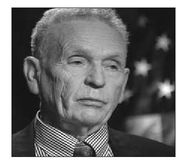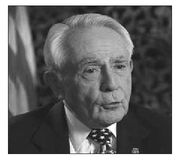War Stories III (47 page)
Authors: Oliver L. North

WILLIAM “BILL” MERRIKEN
went back to college after the war, earned a degree in business administration, and became the head of a successful small business. After selling his business he worked for the Commonwealth of Virginia and in 1999, he returned to the site of the Malmedy Massacre in Belgium, where he nearly lost his life in 1944.
went back to college after the war, earned a degree in business administration, and became the head of a successful small business. After selling his business he worked for the Commonwealth of Virginia and in 1999, he returned to the site of the Malmedy Massacre in Belgium, where he nearly lost his life in 1944.

HARRY KINNARD
made a career of the Army, served in the Korean War, did two tours in Viet Nam and retired as a lieutenant general. He is professor emeritus at the University of Vermont and author of several books on military history and strategy.
made a career of the Army, served in the Korean War, did two tours in Viet Nam and retired as a lieutenant general. He is professor emeritus at the University of Vermont and author of several books on military history and strategy.

EMILE JAMAR
, the paperboy who helped save Bill Merriken's life, graduated from college, became a successful businessman, and later served as the mayor of his town where the Germans and Americans fought during the “Battle of the Bulge.” He and Bill Merriken met for the first time when Bill returned in 1999 for a visit.
, the paperboy who helped save Bill Merriken's life, graduated from college, became a successful businessman, and later served as the mayor of his town where the Germans and Americans fought during the “Battle of the Bulge.” He and Bill Merriken met for the first time when Bill returned in 1999 for a visit.

JOE REGAN
returned to his job as a ship fitter after World War II ended and married his sweetheart, Kay. After working for Centennial Flour Mills, he was employed by Boeing Aircraft for thirty-six years.
returned to his job as a ship fitter after World War II ended and married his sweetheart, Kay. After working for Centennial Flour Mills, he was employed by Boeing Aircraft for thirty-six years.

JOACHIM FEST
became a successful and prolific author and lecturer. His six books on the Third Reich emphasize the gratitude he feels toward the United States for rebuilding Germany and establishing a democratic framework for the modern German state.
became a successful and prolific author and lecturer. His six books on the Third Reich emphasize the gratitude he feels toward the United States for rebuilding Germany and establishing a democratic framework for the modern German state.

ARMIN LEHMANN
recovered from his wounds and after helping his family rebuild their lives, he emigrated to the United States, where he worked thirty-five years in the travel industry. He is the author of
In Hitler's Bunker
, and uses his experiences to warn young people about fanaticism.
recovered from his wounds and after helping his family rebuild their lives, he emigrated to the United States, where he worked thirty-five years in the travel industry. He is the author of
In Hitler's Bunker
, and uses his experiences to warn young people about fanaticism.

ALVIN UNGERLEIDER
received two Purple Hearts during his service in World War II and stayed in the Army. He subsequently served in Korea and Viet Nam and retired as a brigadier general. He is a much sought after speaker at civic and historical events.
received two Purple Hearts during his service in World War II and stayed in the Army. He subsequently served in Korea and Viet Nam and retired as a brigadier general. He is a much sought after speaker at civic and historical events.

RICHARD MAROWITZ
was training in Austria for the invasion of Japan when World War II finally ended. After returning to the U.S. in June of '46 he successfully auditioned for a job as a trumpet player for a band in Spanish Harlem. He subsequently became a successful magician and entertainer in his native New York City.
was training in Austria for the invasion of Japan when World War II finally ended. After returning to the U.S. in June of '46 he successfully auditioned for a job as a trumpet player for a band in Spanish Harlem. He subsequently became a successful magician and entertainer in his native New York City.
GLOSSARY
AA
âAnti-aircraft
âAnti-aircraft
AAA
âAnti-aircraft Artillery
âAnti-aircraft Artillery
Abwehr
âGerman military intelligence service
âGerman military intelligence service
ALT
âAltitude.
âAltitude.
AO
âVariously used for Area of Operations and Aerial Observer
âVariously used for Area of Operations and Aerial Observer
APC
âArmored Personnel Carrier
âArmored Personnel Carrier
API
âArmor Piercing Incendiary
âArmor Piercing Incendiary
ARP
âAir Raid Precautions (Great Britain)
âAir Raid Precautions (Great Britain)
ASW
âAnti-submarine Warfare
âAnti-submarine Warfare
AT
âAnti-tank
âAnti-tank
ATA
âActual time of arrival
âActual time of arrival
AWOL
âAbsent without leave
âAbsent without leave
Axis
âThe 22 May 1939 “Pact of Steel,” formal alliance between Germany and Italy with which Japan became aligned in 1941
âThe 22 May 1939 “Pact of Steel,” formal alliance between Germany and Italy with which Japan became aligned in 1941
Bandit
âHostile or enemy aircraft; also sometimes referred to as a Bogey
âHostile or enemy aircraft; also sometimes referred to as a Bogey
BAR
âBrowning Automatic Rifle
âBrowning Automatic Rifle
BB
âBattleship
âBattleship
Blitzkreig
âGerman slang for “Lightning War;” the term first appeared in the British and American press in 1939, describing the German air-armor assault on Poland
âGerman slang for “Lightning War;” the term first appeared in the British and American press in 1939, describing the German air-armor assault on Poland
CAG
âCarrier Air Group
âCarrier Air Group
CAP
âCombat Air Patrol
âCombat Air Patrol
CC
âCombat Command
âCombat Command
CinC
âCommander in Chief
âCommander in Chief
CNO
âChief of Naval Operations
âChief of Naval Operations
CO
âCommanding Officer
âCommanding Officer
ComNavNAW
âCommander, Naval Forces, North African Waters
âCommander, Naval Forces, North African Waters
CP
âCommand Post
âCommand Post
CPT
âVariously used to abbreviate Captain (Army and Air Force) or Civilian Pilot Training
âVariously used to abbreviate Captain (Army and Air Force) or Civilian Pilot Training
DD
âDestroyer
âDestroyer
DE
âDestroyer Escort
âDestroyer Escort
D-Day
âThe day on which a military operation commences
âThe day on which a military operation commences
DIV or Div
âDivision
âDivision
DUKW
âA multi-purpose, diesel-powered amphibious truck equipped with propellers for moving through water and wheels for use on land
âA multi-purpose, diesel-powered amphibious truck equipped with propellers for moving through water and wheels for use on land
DZ
âDrop zone
âDrop zone
E-Boat
âA German motor torpedo boat, similar to the U.S. PT-Boat
âA German motor torpedo boat, similar to the U.S. PT-Boat
ETA
âEstimated time of arrival
âEstimated time of arrival
ETO
âEuropean Theater of Operations
âEuropean Theater of Operations
FO
âForward Observer
âForward Observer
Führer
âGerman for Leader, the title assumed by Adolf Hitler in 1936
âGerman for Leader, the title assumed by Adolf Hitler in 1936
Gestapo
âGeheime Staatspolize, the internal security organization of the Third Reich, Hitler's secret police
âGeheime Staatspolize, the internal security organization of the Third Reich, Hitler's secret police
Herbstnebel
âGerman for Autumn Mist, the code name for Hitler's Ardennes offensive in December 1944 that the Allies called the “Battle of the Bulge”
âGerman for Autumn Mist, the code name for Hitler's Ardennes offensive in December 1944 that the Allies called the “Battle of the Bulge”
H-Hour
âThe time at which a military operation commences
âThe time at which a military operation commences
Higgins boat
âThe smallest of the U.S. amphibious landing craft, originally designed and built by Higgins Boat Works, New Orleans, LA. The plywood-hulled, diesel-powered, bow-ramp equipped craft could carry thirty-six troops or a jeep and trailer. Also see LCVP
âThe smallest of the U.S. amphibious landing craft, originally designed and built by Higgins Boat Works, New Orleans, LA. The plywood-hulled, diesel-powered, bow-ramp equipped craft could carry thirty-six troops or a jeep and trailer. Also see LCVP
HMS
âHis (or Her) Majesty's Ship, an abbreviated prefix for British naval vessels
âHis (or Her) Majesty's Ship, an abbreviated prefix for British naval vessels
Il Duce
âItalian for “The Leader,” the title assumed by Italian dictator Benito Mussolini
âItalian for “The Leader,” the title assumed by Italian dictator Benito Mussolini
INF or Inf
âInfantry
âInfantry
JCS
âJoint Chiefs of Staff
âJoint Chiefs of Staff
JTF
âJoint Task Force
âJoint Task Force
KIA
âKilled in Action
âKilled in Action
Knot
âA nautical mile, equal to 1.15 land miles, or to 1.85 kilometers
âA nautical mile, equal to 1.15 land miles, or to 1.85 kilometers
LCA
âLanding Craft, Assault
âLanding Craft, Assault
LCI
âLanding Craft, Infantry
âLanding Craft, Infantry
LCVP
âLanding Craft, Vehicle & Personnel, also “Higgins boat”
âLanding Craft, Vehicle & Personnel, also “Higgins boat”
LMG
âLight Machine Gun
âLight Machine Gun
LST
âLanding Ship, Tank
âLanding Ship, Tank
Luftwaffe
âThe German air force
âThe German air force
MIA
âMissing in Action
âMissing in Action
NCO
âA non-commissioned officer; sometimes called non-com
âA non-commissioned officer; sometimes called non-com
MTB
âMotor Torpedo Boat; also E-Boat
âMotor Torpedo Boat; also E-Boat
MOS
âMilitary Occupational Specialty, for armed forces job descriptions
âMilitary Occupational Specialty, for armed forces job descriptions
NKVD
âNarodny Komissriat Vnutrennykh Del, the Soviet internal security organ and intelligence service, predecessor to the KGB
âNarodny Komissriat Vnutrennykh Del, the Soviet internal security organ and intelligence service, predecessor to the KGB
NM
âNautical mile, equal to 1.1508 statute miles, and 1/60th of a degree
âNautical mile, equal to 1.1508 statute miles, and 1/60th of a degree
OKW
âOberkommando des Wehrmacht, Supreme High Command of the German Armed Forces, created by Hitler in 1938 to coordinate the High Commands of the Army (OKH), Navy (OKK), and Air Force (OKL). The OKW was directly responsible to the Führer as commander in chief
âOberkommando des Wehrmacht, Supreme High Command of the German Armed Forces, created by Hitler in 1938 to coordinate the High Commands of the Army (OKH), Navy (OKK), and Air Force (OKL). The OKW was directly responsible to the Führer as commander in chief
OP
âObservation Post
âObservation Post
Other books
Maestra del Alma (Spanish Edition) by Laura Navello
A Battle Raging by Cullars, Sharon
My Love Forgive by Anna Antonia
Split Code by Dorothy Dunnett
Stalked: The Boy Who Said No by Patti Sheehy
05 Dragon Blood: The Blade's Memory by Lindsay Buroker
De cómo me pagué la universidad by Marc Acito
Lifers by Jane Harvey-Berrick
The Tree Where Man Was Born by Peter Matthiessen, Jane Goodall
Magic Bunny: Dancing Days by Sue Bentley